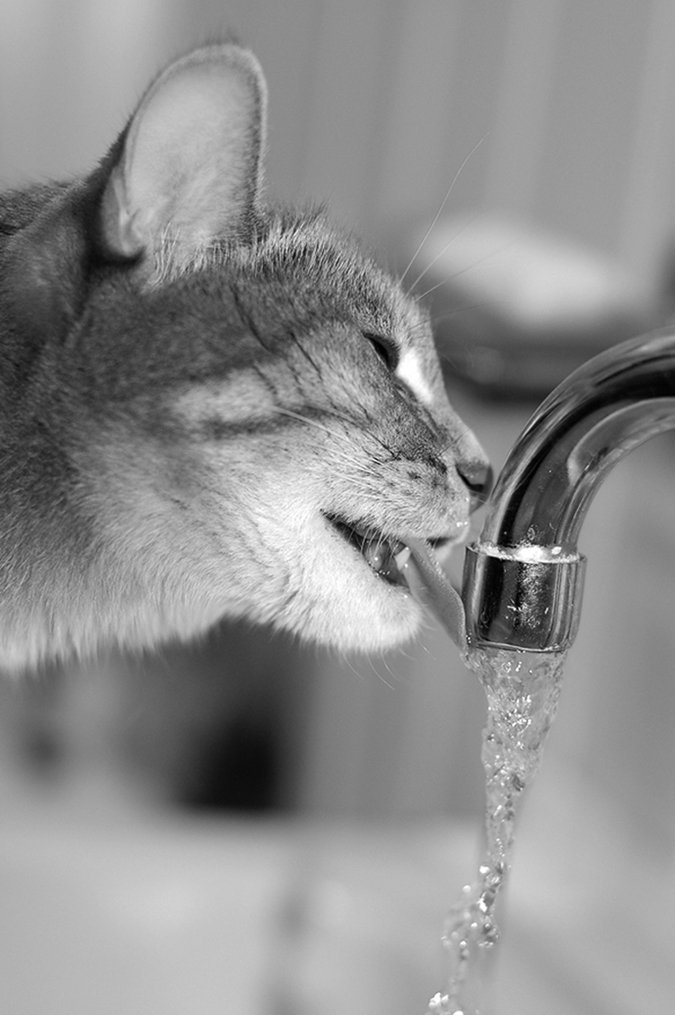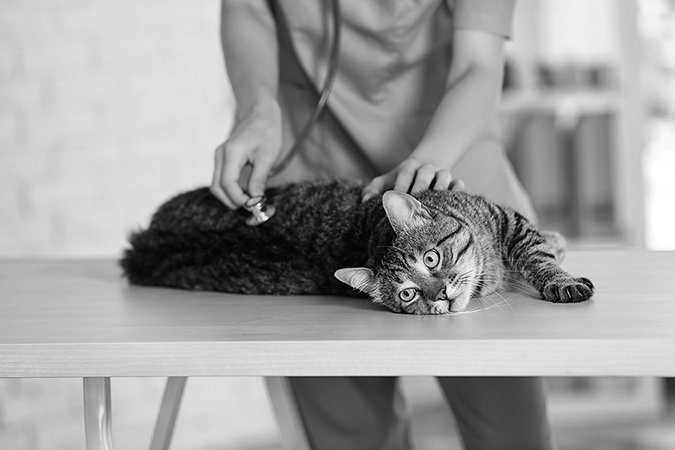Corticosteroids have proven effective in treating a variety of conditions from allergic reactions to brain disease, but they present a balancing act for both owners and veterinarians.
Owners, faced with their cats’ experiencing any one of a long list of health problems, must weigh if long-term use is worth the risk of steroids’ side effects. At the same time, veterinarians must determine the lowest dose of medication to control the condition.
Frequent Vet Exams
“The question isn’t whether side effects will be seen; the question is when they will be seen — and how bad they will be,” says dermatologist William H. Miller, VMD, a medical director of the Companion Animal Hospital at Cornell University College of Veterinary Medicine. “Frequent examinations by the veterinarian are recommended in these cases to detect the changes. Many can be reversed if the drug is stopped early.”
© zzzdim | Bigstock

Corticosteroids, commonly referred to as steroids or cortisone, are a class of steroid hormones produced in the adrenal glands. They’re involved in a range of activities in the body, including nutrient metabolism and maintenance of blood electrolyte levels.
Due to their anti-inflammatory properties, corticosteroids are a valuable class of medications typically used to suppress the inflammation associated with allergies. In higher doses, they can suppress the body’s immune system when a disease causes it to wrongfully attack healthy cells (called autoimmune disease). Most corticosteroids are synthetic and more potent and longer-lasting than the naturally occurring forms. These include:
Prednisone
Prednisolone
Dexamethasone
Triamcinolone
Methylprednisolone
“Steroids address the symptoms of medical conditions rather than the conditions themselves,” Dr. Miller says. “They don’t cure anything. They just control signs of disease.”
Side effects can include increased infection rates and the development of diabetes. According to VCA Animal Hospitals, about 30 percent of cats on long-term steroid treatment suffer a urinary tract infection.
Cats tend to be more resilient than dogs when it comes to steroid side effects, but they may experience both initial and long-term changes. Among the early effects of steroid use in cats are:
– Increased thirst and urination
– Increased appetite with weight gain
– Loss of energy
– Development or worsening of infections, especially bacterial skin infections
– In rare instances, vomiting and diarrhea
Cats undergoing long-term use of steroids may face an even longer list of possible effects, including:
– Internal metabolic changes, such as increased cholesterol, altered liver enzymes and changes in the ability to process glucose
– Altered appearance of the coat and skin, such as a dull coat, hair loss and increased frequency of skin infections
– Altered appearance of the body, such as fat pads over the hips or a pot belly due to weakening of the abdominal muscles
– Loss of muscle mass, especially on the head
– Weakened ligaments
– Thinning of the skin to the point where it can tear easily
– Development of diabetes in some pre-diabetic cats
Older cats are more susceptible to steroids’ effects than young ones. The changes’ type and severity depend on the patient’s health, the drug used, its dosage and route of administration (oral, topical or injectable), and — most important — the length of administration, Dr. Miller says.
Lowering the dosage can often minimize side effects. Alternately, the veterinarian might prescribe another type of corticosteroid. Many newer drugs like cyclosporine and treatments are available as alternatives, but their considerable expensive might deter owners.
Calming an Overactive Immune System
Steroids have strong anti-allergic and anti-inflammatory effects and can help calm an overactive immune system. Among other diseases and conditions, they can treat the following:
Allergies:
– Environmental allergic reactions
– Allergic reactions to flea bites, bee stings or spider bites
– Allergic bronchitis
Inflammatory conditions:
– Osteoarthritis
– Trauma, especially to the head
– Soft tissue injuries like sprains or strains
– Gingivitis, a common form of gum disease
Autoimmune disorders:
– Stomatitis, inflammation in the mouth
– Pemphigus, a skin disease in which numerous pustules form on the skin
– Autoimmune hemolytic anemia, a condition associated with an abnormal breakdown of red blood cells
– Certain kidney diseases
Most Common Uses of Steroids for Cats
In cats, itchy skin disease is the No. 1 reason for chronic use of steroids, Dr. Miller says. “Next come autoimmune disorders of the skin or other organ systems like the bone marrow,” he says. “Many neurologic conditions also require the prolonged use of steroids.”
© Yastremska | Bigstock

Before nonsteroidal anti-inflammatory drugs (NSAIDs) became available for cats, steroids were typically used to control arthritis and other orthopedic disorders, but their use in these conditions has declined as NSAIDs have proven to be effective and relatively safer for long-term treatment than most steroids, Dr. Miller says.
“In most animals, two weeks of steroid administration isn’t likely to cause any long-lasting damage,” he says. “With longer administration, changes can be identified. Some will disappear quickly when the drug is stopped, while others will persist long term or permanently.”
The best way to counter or avoid the effects of long-term steroid use in cats is to explore alternate means of treating the underlying condition. The faster a cat’s underlying health problems are treated, the fewer steroids he’ll have to take.
Possible Alternatives
For example, if your cat is taking a steroid for skin disease, you and his veterinarian should investigate all possible causes for the itching. “If the cause can be identified and eliminated, the need for steroids will disappear,” Dr. Miller says. “If the condition can’t be ‘cured’ — as in a case of chronic environmental allergies such as atopic dermatitis — ask to try some medications or treatments other than steroids.”
For example, Atopica for Cats is a common nonsteroidal drug used to control allergic skin disease. However, its cost can be more than four times that of steroid treatment, with prices varying considerably from practice to practice.
Many nonsteroidal methods can manage chronic itching in cats. Allergy testing and immunotherapy are options in some cases. However, the expense for this type of testing and subsequent treatment can quickly tally into the hundreds of dollars. “To treat the autoimmune conditions, the immune system has to be suppressed,” Dr. Miller says. “There are many drugs that can do this, but they can be more expensive and dangerous for the animal.”
Likewise, various neurologic diseases often require steroidal therapy. These can include brain tumors and trauma to the brain, as well as spinal cord injury and disease. However, surgical options that can correct some of them are becoming increasingly available. Owners should consider these surgeries as a means of avoiding chronic steroid administration in their pets. However, like certain drug alternatives to steroids, surgical costs can be prohibitive, leaving steroids the only option.
“If steroids are the only acceptable way to manage a condition, the animal should receive the lowest dosage possible, as infrequently as possible,” Dr. Miller says. “In skin disease, it’s better to leave most allergic pets a little itchy rather than increase the drug dosage to completely eliminate the itching.”
While corticosteroids can be life-saving medications for many cats, owners need to work with their cats’ veterinarian to ensure that these drugs are administered as safely as possible and should seek alternatives that could potentially improve their pet’s long-term quality of life.
The Essential Monitoring Tests
Because steroids suppress the immune system, cats taking them can be vulnerable to viruses, bacteria and other infections. While healthy cats should see their veterinarians for checkups twice a year, those taking long-term steroids should see their veterinarians more often.
During these visits, veterinarians will conduct urine and blood tests to screen for infections or signs of damage and make sure the cat is handling the steroid medication well. They might decide to alter the dosage or switch to an alternative medication if certain side effects become evident.
The Rare Risk of Cushing’s Disease
In rare cases, excessive corticosteroid production by the adrenal glands may cause hyperadrenocorticism, or Cushing’s disease, in cats. When a cat is on long-term, high-dose steroid therapy, the risk that he will develop medication-induced, or iatrogenic, Cushing’s disease increases.
Signs of this condition can include increased thirst and urination, an increase in skin or urinary tract infections, a pot-bellied appearance and thinning skin and hair loss.
To minimize the risk, veterinarians will try to gradually reduce corticosteroid doses over time. If iatrogenic hyperadrenocorticism does occur, it’s also usually managed by gradual withdrawal of the corticosteroid.



